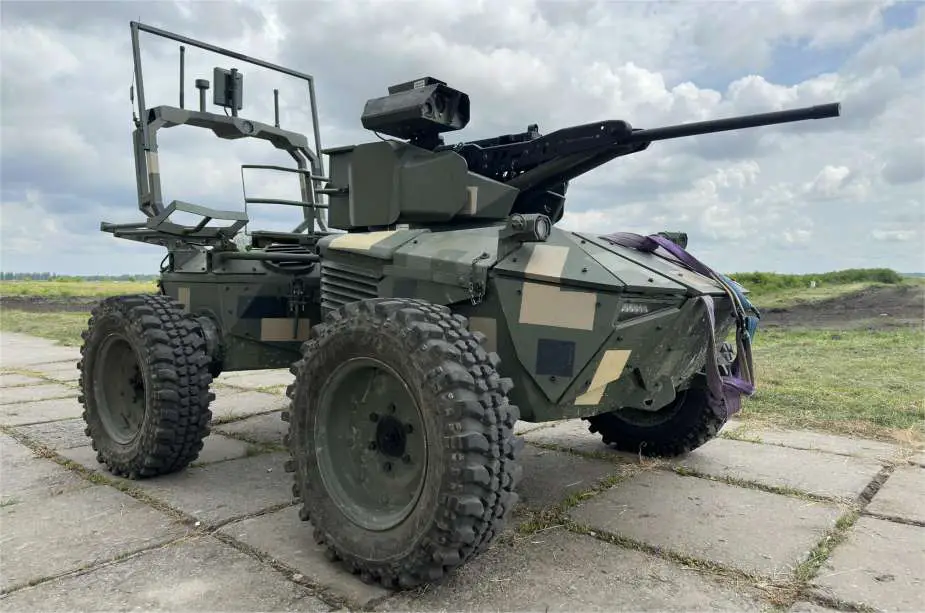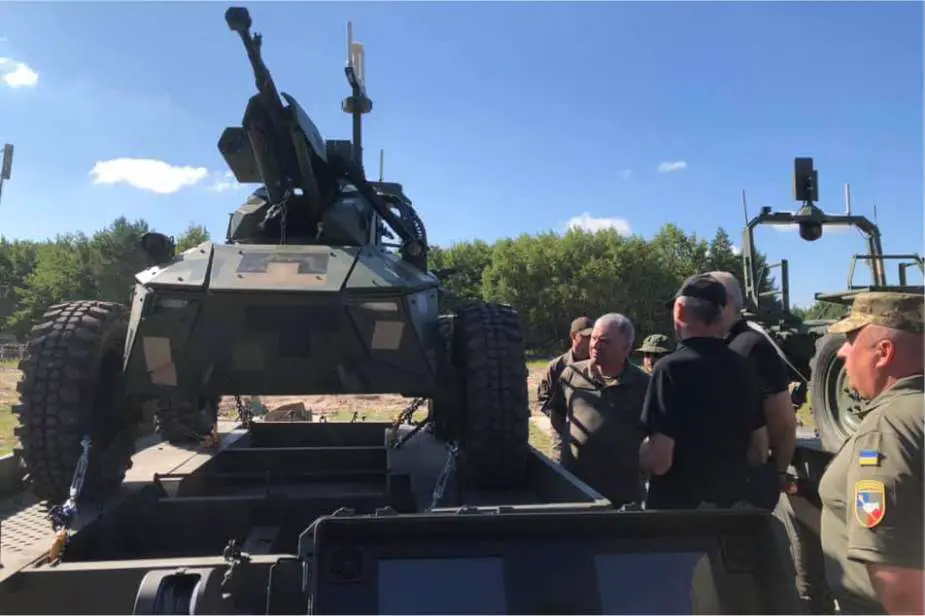- Army
- Conflicts in the world
- Israel - Iran conflict 2025
- Pakistan - India Conflict 2025
- Russia Ukraine War 2022
- Libya conflict day by day
- HAMAS - Israel War 2023
- Operation Serval in Mali French Army
- Sangaris operation Central African Republic
- Sangaris opération militaire République Centreafrique
- Ukraine - Russia conflict
- Syria conflict news
- Defence & Security Industry Technology
- Armies in the world
- Analysis Defense and Security Industry
- Conflicts in the world
- Navy
- Air
Ukraine to deploy Ironclad articulated UGV in combat operations
According to Ukraine's Minister of Digital Transformation, Mykhailo Fedorov, on September 21, 2023, the Ukrainian Armed Forces initiated field testing of the Ironclad unmanned ground vehicle (UGV). This versatile UGV will perform a range of combat missions, including storming enemy positions, reconnaissance operations, and delivering military fire support. Central to its capabilities is the Shablya M2 combat module, equipped with a thermal imaging camera for enhanced situational awareness.
Follow Army Recognition on Google News at this link

The Ironclad UGV features an articulated frame and a Shablya M2 combat module (Picture source: Mykhailo Fedorov/Facebook)
The Ironclad UGV has an articulated frame, an empty weight of 1,800 kg, and a load capacity of 400 kg, with a portion of this capacity allocated for the combat module. Operating on a 4x4 configuration, it can achieve a top speed of 20 km/h on the road and 10 km/h offroad, with a remote control range of 5 km. The UGV has a ground clearance of 40cm, can drive through water 40cm deep, and overcome trenches up to 50 cm. In terms of dimensions, the UGV has a length of 2,8m, a width of 1,85m, and a height of 1,46m.
The UGV's armored carapace provides protection against small arms fire up to the level of 7.65x54 mm armor-piercing bullets. Importantly, the Ironclad UGV can be remotely controlled, operate autonomously, or integrate seamlessly with other systems, enhancing its adaptability in various combat scenarios. The armament of the Ironclad is the M2 variant of the Shablya remotely-controlled combat module, which has a weight of 180 kg (without a weapon and ammunition), a length of 1,22m, a width of 0,83m, and a height of 0,51m. The module could rotate at 360°, with an object detection range of 5km and a human detection range of 1,8km.
One distinctive advantage of an articulated chassis, as seen in the Ironclad, is its exceptional maneuverability, attributed to its ability to achieve a tighter turning radius. This feature is particularly valuable in navigating challenging terrain, such as damaged buildings, forested areas, minefields, and large trench networks. The articulated chassis reduces the risk of collisions with other vehicles or obstacles on the battlefield, enhancing overall safety and effectiveness.
Moreover, articulated vehicles like the Ironclad demonstrate superior off-road performance compared to their rigid counterparts. The inherent turning capability of articulated steering systems mitigates torque and pressure, ensuring stability while traversing uneven or rocky terrain. Many articulated vehicles also have large tires, wider frames, and lower centers of gravity, further contributing to their off-road suitability.
The development and production of the Ironclad UGV were conducted by Roboneers, a Ukrainian company comprising teams of engineers, electronic engineers, ex-military personnel, and IT specialists specializing in UAVs, remote control modules, software, situational awareness programs, and remotely controlled platforms. This collaborative effort received support from the Brave1 cluster, an initiative established by the Government of Ukraine to foster collaboration within the defense tech industry, offering organizational, informational, and financial support to defense tech projects.
The origins of the Ironclad project can be traced back several years, with the prototype first unveiled at the Arms and Security Exhibition in Kyiv in 2018. At that time, the prototype had a weight of 1,100 kg and dimensions of 2.57 m in length, 1.7 m in width, and 0.96 m in height. The front module could accommodate light, medium, or heavy machine guns, while the rear module had the capacity to carry payloads of up to 200 kilograms. Powered by diesel generators driving hub-mounted electric motors, the UGV could operate for up to four hours in hybrid mode or ten hours when unburdened, with a maximum range of around 130 kilometers, ideal for missions such as reconnaissance, surveillance, and target acquisition.

The Ironclad UGV during tests in 2021 (Picture source: Roboneers)
In 2021, Ukraine's Air Assault Command conducted preliminary assessments of advanced ground combat drones, including the Ironclad. Comparative tests of Ukrainian developments in its drone manufacturing sector took place in August 2021, facilitated by the Ministry of Defense of Ukraine.
Ukraine has seen remarkable growth in its drone manufacturing sector over the past year, expanding from just seven companies to a minimum of 80 presently engaged in drone production. Minister Mykhailo Fedorov reported a staggering increase in production by a factor of 100 in 2023 compared to 2022, with further projected growth estimated at 120 to 140 times higher than 2022 levels.
This expansion encompasses various types of unmanned vehicles, including Unmanned Surface Vehicles (USVs) for maritime applications, Unmanned Aircraft Vehicles (UAVs), and Unmanned Ground Vehicles (UGVs). These drones serve diverse military functions, encompassing surveillance, intelligence gathering, and engagement with enemy forces.
Ukraine's drones are known for their cost-effectiveness, with some models priced as low as $500, yet demonstrating the capability to effectively target and neutralize high-value enemy tanks worth significantly more. This affordability has played a pivotal role in driving the growth of Ukraine's drone fleet, attracting a multitude of manufacturers to the industry.
Additionally, Ukraine manufactures more advanced UAVs primarily designed for reconnaissance purposes, with price tags exceeding $1 million. These advanced drones offer extended flight times, high operational altitudes, and basic artificial intelligence capabilities, enhancing their capacity to identify targets accurately and evade electronic warfare measures employed by adversaries.
These unmanned systems have proven strategically vital in Ukraine's military operations. Notably, they have played a pivotal role in mapping out Russian air defense systems and effectively targeting enemy forces and infrastructure. Despite their relatively low cost, these drones have demonstrated the potential to influence the outcome of significant military operations, such as the recent targeting of a Russian submarine in Sevastopol or the destruction of four Ilyushin Il-76MD transport aircraft on the Pskov military airfield, deep within Russian territory.


























